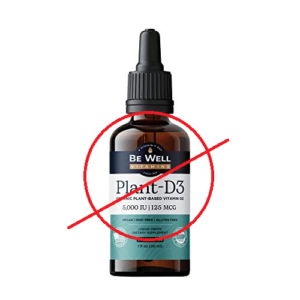Vitamin D.
Several articles by doctors and scientists follow my discussion.
This supplement should be taken at the same meal as your main coffee (which is your magnesium source from real food) and your vitamin K supplement.
DO NOT purchase and use vitamin D supplements that are designed with magnesium and vitamin K in them.
The magnesium taken as a supplement will be harmful and you won’t be able to otherwise dose your vitamin D (or K for that matter) without affecting your magnesium supplement (which is harmful to your intestines and other problems when ingested as a supplement).
With that said, the most important starting point with Vitamin D is to TEST your levels of this regularly (twice a year if stable levels, or at least 2-3 times when you are trying to find your level) for quantities to use. This is one of the most important supplements to use. Your dose will usually be 1000-2000 per day but some people need a little more and some less. You must TEST your levels.
When purchasing a vitamin D supplement, you want to look for a safe oil type (vitamin D needs oil to be more bioavailable). This will be olive oil.
You will want to look for a brand without any fillers, stearates, starches or bad oils.
And you want to look for a brand that is tested for toxins in the supplement materials.
Gelcaps and Softgels will have the toxins of anything in the gelatin of the capsule.
The oils, of any kind, will have the toxins of the oils in it.
Fish oils and MCT oils are dangerous.
You will want to look for a supplement that’s ONLY vitamin D, not in combo with any other supplement.
While vitamin D in combo with say vitamin K2 and magnesium is beneficial and important, you still want to be able to regulate the amount of EACH ONE SEPARATELY.
You will also want to look for a formulation that allows you to regulate how much you regularly take and generally you want a brand with minimum doses of 1,000 or 2,000 IU MAX per dose.
Many vitamin D supplements come in doses of 5,000 IU or 10,000 IU. This amount is too high for most people for long term supplementation.
You can use the higher doses only if you become acutely infected with something that you will heal in a couple weeks, or if you have been dosing under 2,000 IU per day and want to immediately boost your body levels to a higher amount for a week only before taking a different maintenance dose.
I use Vitamin D from this company in softgels with olive oil (olive oil can be a source of contaminants, but this company tests). This same company also sells it in drops but that has MCT oil and I avoid that.
I don’t recommend buying Vitamin D drops. Drops are very hard to control the dose. Just one drop is often already 2,000 or even 5000 IU. Drops then end up being different drops sizes. People are fooled that the Vitamin D is harmless and squirt the drops into their mouth instead of on a spoon–potentially REALLY overdosing it. So buy your Vitamin D pre-measured per serving. It’s otherwise too easy to overdose. Also, I don’t trust the drops to be well homogenized. Exactly how much is in each drop? Without having expensive testing equipment to find out, it’s just not worth it. Get the brands with individual servings already contained in a gelcap or capsule.
So use caution dosing liquid vitamin D supplements and NEVER buy or use the 5,000 IU per drop varieties.
Be sure wherever you purchase your brand that they test the product and batches sold for effectiveness and for contaminants of their carrier oils
However, Vitamin D is actually a hormone and there are negative side effects when dosing this too high. If you push your levels well over 100 ng/mL blood level for a period of time, it could take almost a year without using it at all to return to normal levels.
Side effects can be severe, almost as if one overdosed on caffeine and thyroid medications. It can really toss your thyroid readings and thyroid supplementation meds off. Some people, myself included, can immediately feel light headed and heart palpitations just from taking one 5,000 – 6,000 IU dose.
And it takes a long time to wear off.
Optimal body levels should be about 50-60 ng/mL level in a blood test.
The tests will note that 30 ng/mL is still within recommended range. IT IS NOT. THIS IS TOO LOW. AND YOU MOST LIKELY WILL STILL EXPERIENCE LOW Vitamin D SYMPTOMS.
Using 5,000-10,000 IU Vit. D per day ONLY for a few days or a week can boost your levels to the range fairly quickly. However, some people then experience an overdose by taking that amount as maintenance.
It’s more, and often too much more, than they need to maintain: 5,000 IU—or even more—as their maintenance dose for too long a period of time in a row can display side effects.
Once the optimal blood reading range is met, most people need 1,000 to 2,000 per day to maintain.
You will only know your correct dose by running 2 or 3 tests over a period of time and monitoring your symptoms.
Try your best NOT to overdose. If you overdose, it could take a year to re-regulate your levels to normal. Taking too much for too long can be harmful!
In most states, without needing to visit a doctor office, you can test this, and thyroid and other tests for yourself here and here and here you can get a kit and test at home.
HACK:
Taking a vitamin D test before you make any changes is a sound idea.
If your blood test comes back under 50 ng/ML, and your daily dose has been less than 3,000 IU per day, then take 10,000 IU vitamin D for 5 days in a row.
Then start a maintenance dose of 1,000-1,500 IU per day for a month.
And run a second vitamin D blood test. You should be in range of 50-60 ng/ML blood level range.
If you have already been taking 2,000 IU per day for awhile and your blood tests still come in low, you can bump your dose to 3,000 IU per day AND be sure your water, food and supplements are clean of toxins and per the recommendations here for at least 3 months before testing again.
Or choose a different brand of vitamin D. It’s possible that a cheap brand is fraudulently labeled for quantity.
Aluminum toxins combine with glyphosate toxins and microwave wifi emissions. These environmental poisons in our food, air, and water can cause your levels of optimum nutrients to change for the worse.
Just taking more vitamin D or more of any other supplement cannot fix the entire range of your maladies.
Do what you can to handle your environment, water, food, minimal supplements before overdosing on vitamin D.
And you could damage yourself further in the process.
There is no magic bullet, but in synergy, your body can come into optimal health.
From Thorne.com vitamin D test website page information, their tests and information are very useful:
(For supplementation, while Thorne’s products are very high quality, tested products, their vitamin D offering is in MCT oil, and/or in capsules with other fillers and excipients and/or some offerings of D are combined with other nutrients like K2, and for a variety of reasons should be purchased as a single supplement. I do not recommend Thorne for a vitamin D supplement choice.)
Potential symptoms of high vitamin D
Although having a vitamin D level that is too high can be asymptomatic, with a very high level (usually a result of excess calcium absorption) you could experience:
- Anorexia/loss of appetite
- Vomiting
- Diarrhea and/or constipation
- Excessive thirst, dry mouth
- Frequent urination
- Fatigue
- Dizziness
- Muscle cramping/pain/twitching
- Bone pain
- Nerve pain (neuropathy)
- Kidney stones
- Confusion and weakness
- Chest pain, irregular heart beat
- Elevated blood pressure
- Headaches
- Cough, shortness of breath
If you suspect you might have an excess level of vitamin D (which only occurs with excessive supplementation and is very uncommon), then you should consult with your health-care practitioner.
The following article on the side effects of vitamin D is from the former Vitamin D Council way-back-machine (website now disbanded):
Am I getting too much vitamin D?
Although most people take vitamin D supplements without any problems, it’s possible to take too much. This is called vitamin D toxicity. Vitamin D toxicity, where vitamin D can be harmful, usually happens if you take 40,000 IU per day for a couple of months or longer, or take a very large one-time dose.
Vitamin D is fat-soluble, which means your body has a hard time getting rid of it if you take too much. When you take large amounts of vitamin D, your liver produces too much of a chemical called 25(OH)D.
When your 25(OH)D levels are too high, this can cause high levels of calcium to develop in your blood. High blood calcium is a condition called hypercalcemia.
The symptoms of hypercalcemia include:
- feeling sick or being sick
- poor appetite or loss of appetite
- feeling very thirsty
- passing urine often
- constipation or diarrhea
- abdominal pain
- muscle weakness or pain
- bone pain
- feeling confused
- feeling tired
In some rare diseases, you may be at risk of hypercalcemia even if you have low vitamin D levels and haven’t taken much vitamin D. These diseases include primary hyperparathyroidism, sarcoidosis and a few other rare diseases. See our Hypersensitivity page page for more information.
How do I know if I have taken too much?
A blood test to measure your 25(OH)D levels can tell you whether you have too high of vitamin D levels. If your 25(OH)D levels are above 150 ng/ml this is considered potentially toxic and potentially harmful to your health. You know if your 25(OH)D levels are toxic by a blood test to measure calcium. If calcium is high and 25(OH)D is high, then you are getting too much vitamin D.
Very high levels of 25(OH)D can develop if you:
- take more than 10,000 IU/day (but not equal to) everyday for 3 months or more. However, vitamin D toxicity is more likely to develop if you take 40,000 IU/day everyday for 3 months or more.
- take more than 300,000 IU in a 24 hour period.
If you have taken this much vitamin D, seek medical attention. Your health providers will get your calcium and 25(OH)D levels tested.
The current recommended daily allowances for vitamin D set by the Food and Nutrition Board are conservative, so you don’t need to feel worried about toxicity if you take more than their recommended daily allowance. You can find out more about daily vitamin D supplementation on our page, How do I get the vitamin D my body needs?
What should I do if I think I have taken too much vitamin D?
Have you taken more than 300,000 IU in the past 24 hours OR have you been taking more than 10,000 IU/day for the past three months or longer?
- If yes, check to see if you have symptoms of toxicity (listed above); symptoms like feeling sick, feeling thirsty, constipation or diarrhea, poor appetite and feeling confused. If so, you may have hypercalcemia and need medical attention.
- If you do not have any symptoms, you likely do not have hypercalcemia. However, you should get a blood test for 25(OH)D and make sure that you do not have a level above 150 ng/ml. Consider lowering your vitamin D dose. See our page How do I get the vitamin D my body needs? for more information.
- If no, you likely do not have hypercalcemia and are not toxic. If you are still concerned, you may choose to get a blood test to measure 25(OH)D to see what your levels are. See our Testing page for more information.
- If you have symptoms of toxicity but have not taken more than 300,000 IU in 24 hours or more than 10,000 IU/day for the past three months, you may have a very rare condition that is sensitive to vitamin D. Please see our Hypersensitivity page for more information.
I already tested my 25(OH)D. Is my level too high?
If your level is greater than 150 ng/ml, this is considered too high and potentially toxic. Seek medical attention if you have symptoms of hypercalcemia (listed above). If you do not have symptoms, consider lowering your level. Please see our pages on 25(OH)D reference ranges and our page on how to get the right amount of vitamin D:
If your level is not greater than 150 ng/ml, then you are not potentially toxic in vitamin D. Please read our pages on vitamin D levels and how to interpret your results:
References
-
Cusano NE, Thys-Jacobs S and Bilezikian JP. “Hypercalcemia Due to Vitamin D Toxicity.” In Vitamin D, Third Edition, by Feldman D, Pike JW and Adams JS. Elsevier Academic Press, 2011.
-
Vieth, R. Vitamin D supplementation, 25-hydroxyvitamin D concentrations, and safety. American Journal of Nutrition, 1999.
From Dr. Robert Malone, MD MS:
“The Ugly History of Vitamin D3 and Fauci’s pro-Vaccine Bias. The inconvenient truth is that even at the beginning of the COVID-19 pandemic, a very simple, inexpensive and effective treatment was available that could have saved the majority of lives lost (1-3). All that the WHO and public health bureaucracy had to do was to recommend and support people taking sufficient Vitamin D3. “
And from Dr. Joseph Mercola:
mercola-vitD-toxic-magnesium-vitamin-d-supplementation2




